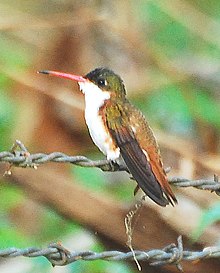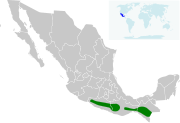| Ramosomyia | |
|---|---|

| |
| Cinnamon-sided hummingbird, (Ramosomyia wagneri) | |
| Scientific classification | |
| Domain: | Eukaryota |
| Kingdom: | Animalia |
| Phylum: | Chordata |
| Class: | Aves |
| Clade: | Strisores |
| Order: | Apodiformes |
| Family: | Trochilidae |
| Tribe: | Trochilini |
| Genus: | Ramosomyia M.D. Bruce & F.G. Stiles, 2021 |
| Species | |
|
3, see text | |
| Synonyms | |
|
Leucolia | |
Ramosomyia is a genus in family Trochilidae, the hummingbirds, that was created in 2021 to replace Leucolia.
Taxonomy and species list
[edit]The genus contains three species:[1]
| Common name | Scientific name and subspecies | Range | Size and ecology | IUCN status and estimated population |
|---|---|---|---|---|
| Violet-crowned hummingbird | Ramosomyia violiceps (Gould, 1859) Two subspecies
|
Mexico and the southwestern United States.
|
Size: Habitat: Diet: |
LC
|
| Green-fronted hummingbird | Ramosomyia viridifrons (Elliot, 1871) |
Mexico and possibly Guatemala
|
Size: Habitat: Diet: |
LC
|
| Cinnamon-sided hummingbird | Ramosomyia wagneri (Phillips, AR, 1966) |
Mexico
|
Size: Habitat: Diet: |
LC
|
These species were early placed in the genus Amazilia. A molecular phylogenetic study published in 2014 found that the genus Amazilia was polyphyletic.[2] In the revised classification to create monophyletic genera, these Mexican species were placed in the resurrected genus Leucolia by some taxonomic systems.[3] However, a study published in 2021 showed that Leucolia was not available because of the principle of priority. The authors proposed the new genus Ramosomyia and in mid-2022 it was adopted by the North American Classification Committee of the American Ornithological Society and the International Ornithological Committee.[4][5][1] As of that date the Clements taxonomy retains the three species in Leucolia and BirdLife International's Handbook of the Birds of the World in the earlier Amazilia.[6][7]
References
[edit]- ^ a b Gill, F.; Donsker, D.; Rasmussen, P., eds. (August 2022). "Hummingbirds". IOC World Bird List. v 12.2. Retrieved August 8, 2022.
- ^ McGuire, J.; Witt, C.; Remsen, J.V.; Corl, A.; Rabosky, D.; Altshuler, D.; Dudley, R. (2014). "Molecular phylogenetics and the diversification of hummingbirds". Current Biology. 24 (8): 910–916. Bibcode:2014CBio...24..910M. doi:10.1016/j.cub.2014.03.016. PMID 24704078.
- ^ Stiles, F.G.; Remsen, J.V. Jr.; Mcguire, J.A. (2017). "The generic classification of the Trochilini (Aves: Trochilidae): Reconciling taxonomy with phylogeny". Zootaxa. 4353 (3): 401–424. doi:10.11646/zootaxa.4353.3. PMID 29245495.
- ^ Bruce, M.D.; Stiles, F.G. (2021). "The generic nomenclature of the emeralds, Trochilini (Apodiformes: Trochilidae): two replacement generic names required". Zootaxa. 4950 (2): 377–382. doi:10.11646/zootaxa.4950.2.8. PMID 33903443. S2CID 233410575.
- ^ "Check-list of North and Middle American Birds". American Ornithological Society. August 2022. Retrieved August 9, 2022.
- ^ Clements, J. F., T. S. Schulenberg, M. J. Iliff, S. M. Billerman, T. A. Fredericks, J. A. Gerbracht, D. Lepage, B. L. Sullivan, and C. L. Wood. 2021. The eBird/Clements checklist of Birds of the World: v2021. Downloaded from https://www.birds.cornell.edu/clementschecklist/download/ Retrieved August 25, 2021
- ^ HBW and BirdLife International (2021) Handbook of the Birds of the World and BirdLife International digital checklist of the birds of the world. Version 6. Available at: http://datazone.birdlife.org/userfiles/file/Species/Taxonomy/HBW-BirdLife_Checklist_v6_Dec21.zip retrieved August 7, 2022



Well, that’s interesting to know that Psilotum nudum are known as whisk ferns. Psilotum nudum is the commoner species of the two. While the P. flaccidum is a rare species and is found in the tropical islands. Both the species are usually epiphytic in habit and grow upon tree ferns. These species may also be terrestrial and grow in humus or in the crevices of the rocks.
View the detailed Guide of Psilotum nudum: Detailed Study Of Psilotum Nudum (Whisk Fern), Classification, Anatomy, Reproduction